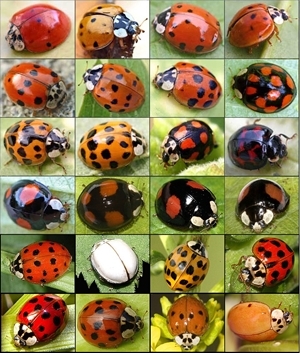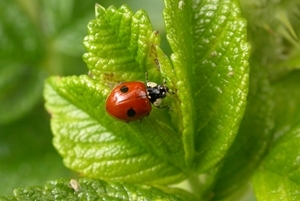Key points
- Harlequin ladybirds are a highly invasive non-native species that have spread rapidly through the UK since their arrival in 2004.
- Two-spot ladybirds are small native species whose numbers are declining. The role of harlequin ladybirds in this decline is not well understood.
- This study used feeding trials to see how the two species interacted.
- Harlequin ladybirds were able to find and consume food items up to four times faster than two-spot ladybirds.
- The number of aggressive interactions was lower than expected, suggesting this is not the reason native species are in decline.
- More research is needed to further investigate this relationship in other situations.
Background
 Harlequin ladybirds originate from Asia and were first introduced to Europe in the 1980s to help control pest insects. They were first recorded in the UK in 2004 and are now the most common ladybird in England. Compared to other non-native species, such as grey squirrels, the ladybird has spread throughout the UK very rapidly, and is now considered the most invasive species of ladybird on Earth.
Harlequin ladybirds originate from Asia and were first introduced to Europe in the 1980s to help control pest insects. They were first recorded in the UK in 2004 and are now the most common ladybird in England. Compared to other non-native species, such as grey squirrels, the ladybird has spread throughout the UK very rapidly, and is now considered the most invasive species of ladybird on Earth.
Harlequin ladybirds are 7-8mm in size and have over 100 different colour variations, with different individuals having between 0 and 21 spots and being orange, red or black in colour. This variation sometimes makes them difficult to identify, but the most common forms are orange with 15-21 black spots or black with 2-4 red spots.
Two-spot ladybirds are native to the UK and are a relatively common predator of insects called aphids. Measuring 4-5mm, they are much smaller than harlequin ladybirds. There is some variation in their appearance, but generally they are red with two black spots. Two-spot ladybirds can be found across a range of environments and are the most common native ladybird species in Britain.
| What are invasive species? |
|
Invasive species are plants and animals that have been
introduced to places they do not naturally occur. There is
a clear relationship between the success of invasive species
and the decline of native wildlife, and a good understanding
of this dynamic helps to prevent future problems. They are
successful due to factors such as:
- Ability to thrive in a wide range of environments and climates
- Ability to respond quickly to changes in the environment
- Ability to spread across landscapes
- High resistance to disease
- Varied diet and feeding methods
|
Both species of ladybird hunt and consume aphids, which are one of the biggest pest insects for crops in the UK. Aphids are sap-sucking insects that feed on a wide range of crop plants including many fruits and vegetables. As they feed the aphids damage plants and can spread diseases, which can have large impacts on crop yields. As a result, ladybirds are important predators of these pests to help minimise their negative impact.
Unfortunately, two-spot ladybirds are in decline, and some research suggests that this coincided with the arrival of the harlequin ladybirds. Both kinds of ladybird compete for the same habitats and limited sources of aphid food. Harlequin ladybirds are larger and considered more aggressive, so there is mounting concern about their impact on British ladybirds. This study set out to observe how the two ladybirds interact with each other.
What they did
The scientists investigated the impact that harlequin ladybirds had on the feeding behaviour of two-spot ladybirds. Harlequin and two-spot ladybirds were collected in 2016 and allowed to hibernate over winter under cool, storage conditions.
Once the ladybirds had emerged from hibernation, 60 feeding trials were carried out in 2017. These trials involved growing wheat in containers and releasing aphids at low and high densities.
The scientists compared how the ladybirds interacted with each other when feeding at low and high aphid densities, comparing two two-spot ladybirds together, and harlequin and two-spot ladybirds together.
Ladybirds of both species were chosen at random and starved for 24 hours before being released into the containers with wheat. Ladybirds were released into containers in pairs and observed for 30 minutes, until a total of 120 ladybirds were observed. Several observations were made during the feeding trials, including:
- Location time – time taken to discover aphid prey
- Consumption time – time taken to consume one aphid
- Consumption rate – number of aphids consumed by an individual ladybird
- Interactions – the number of aggressive and non-aggressive contacts between ladybirds
What they found
Across all 60 feeding trials, harlequin ladybirds had a shorter location time, finding food items faster than two-spot ladybirds. Aphids were also located faster when they were released in high densities.
Generally, two-spot ladybirds had a similar prey consumption time whether harlequin ladybirds were present or absent. However, harlequin ladybirds were able to consume prey more quickly than two-spot ladybirds when aphids were at a high density.
The consumption rate of aphid prey was significantly higher when harlequin ladybirds were present, regardless of the density of aphids, with harlequin ladybirds consuming 3-4 times more aphids than two-spot ladybirds. Despite that, the number of aphids consumed by two-spot ladybirds did not change in the presence of harlequin ladybirds.
Across the feeding trials, there were only 31 observed interactions between ladybirds, with more contacts made when aphids were at a high density. Most aggressive interactions were made between individuals of the same species attempting to steal prey from one another, leading to observation of chasing and avoidance behaviour. Aggressive interactions between harlequin and two-spot ladybirds were lowest when aphids were at high densities.
What does this mean?
 In this study scientists observed that native two-spot ladybirds tended to focus their effort on finding aphid prey in a small area at a time, whereas harlequin ladybirds searched in a wider area. As a result, harlequin ladybirds were able to find and consume aphid prey faster than two-spot ladybirds could, regardless of the number available.
In this study scientists observed that native two-spot ladybirds tended to focus their effort on finding aphid prey in a small area at a time, whereas harlequin ladybirds searched in a wider area. As a result, harlequin ladybirds were able to find and consume aphid prey faster than two-spot ladybirds could, regardless of the number available.
The low level of aggressive interactions between the two species suggests that they can coexist alongside each other. In natural environments, ladybirds are more likely to spread out rather than hunt prey in the same area, and so the results of this trial suggest that aggressive interactions are likely to be uncommon between the ladybirds in the wild. This has also been seen in Japan, where the harlequin ladybird is native and the two-spot ladybird is non-native, having been introduced in 1993 to control pests.
This study suggests that the main reason harlequin ladybirds dominate over native species is because they are better predators, not because they are aggressive or prevent two-spots from accessing food. In this case, harlequin ladybirds provide what is called indirect competition, where they find food more easily and as a result there may be less available for two-spot ladybirds. If two-spot ladybirds cannot find sufficient food, this could be a driver for their decline.
However, research from 2017 suggests that two-spot ladybirds and their aphid prey have been in decline for close to 40 years. This means that the arrival and continued presence of harlequin ladybirds could be adding to the pressures two-spot ladybirds already faced, rather than being the main cause.
In the natural environment there are many factors such as habitat and climate change that can cause the increase or decline of species. Although this study suggests that harlequin ladybirds do not pose a direct threat to two-spot ladybirds, more research is needed in different contexts to better understand their relationship and identify the key drivers of native ladybird decline.
Read the original abstract
Hemsley, J., & Holland, J. (2021). Does the non-native Harlequin ladybird disrupt the feeding behaviour of the native two-spot ladybird? Bulletin of Entomological Research, 1-5.
Photo credits: Thinglink, UK Beetle Recording